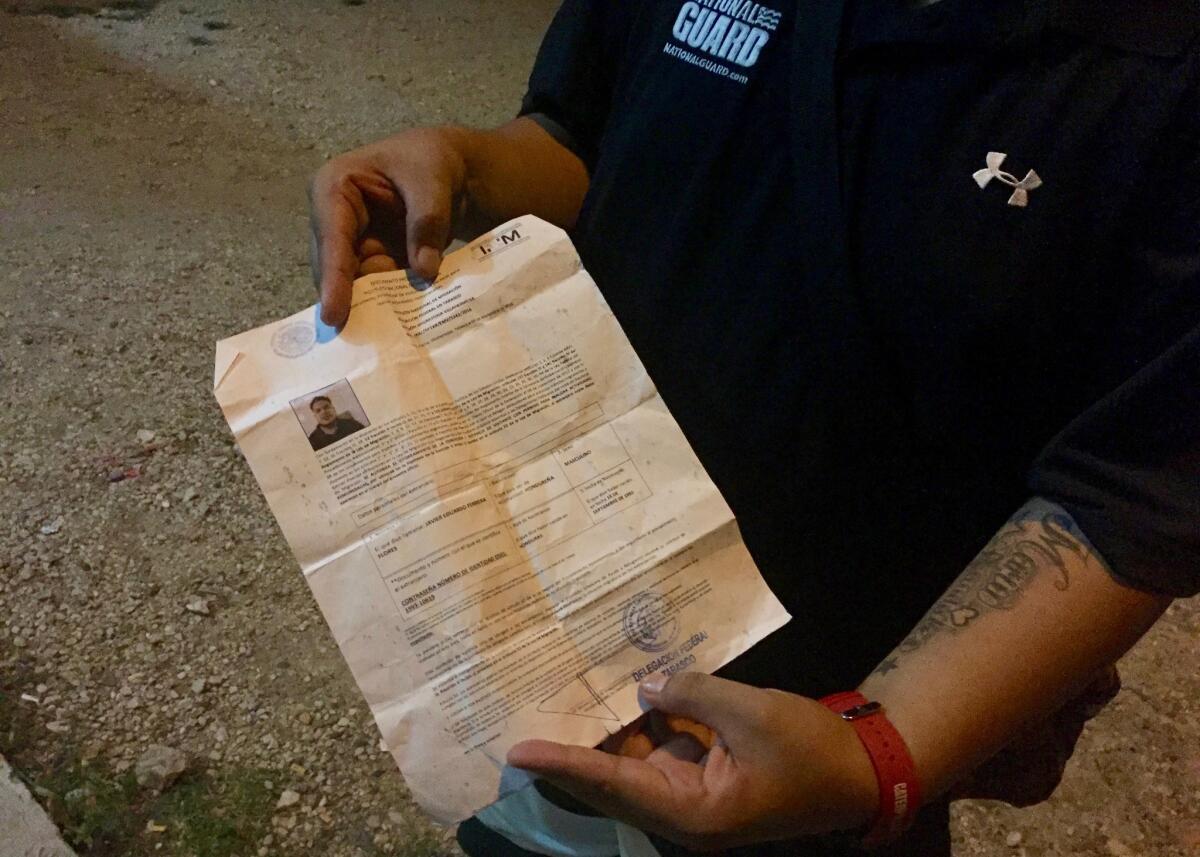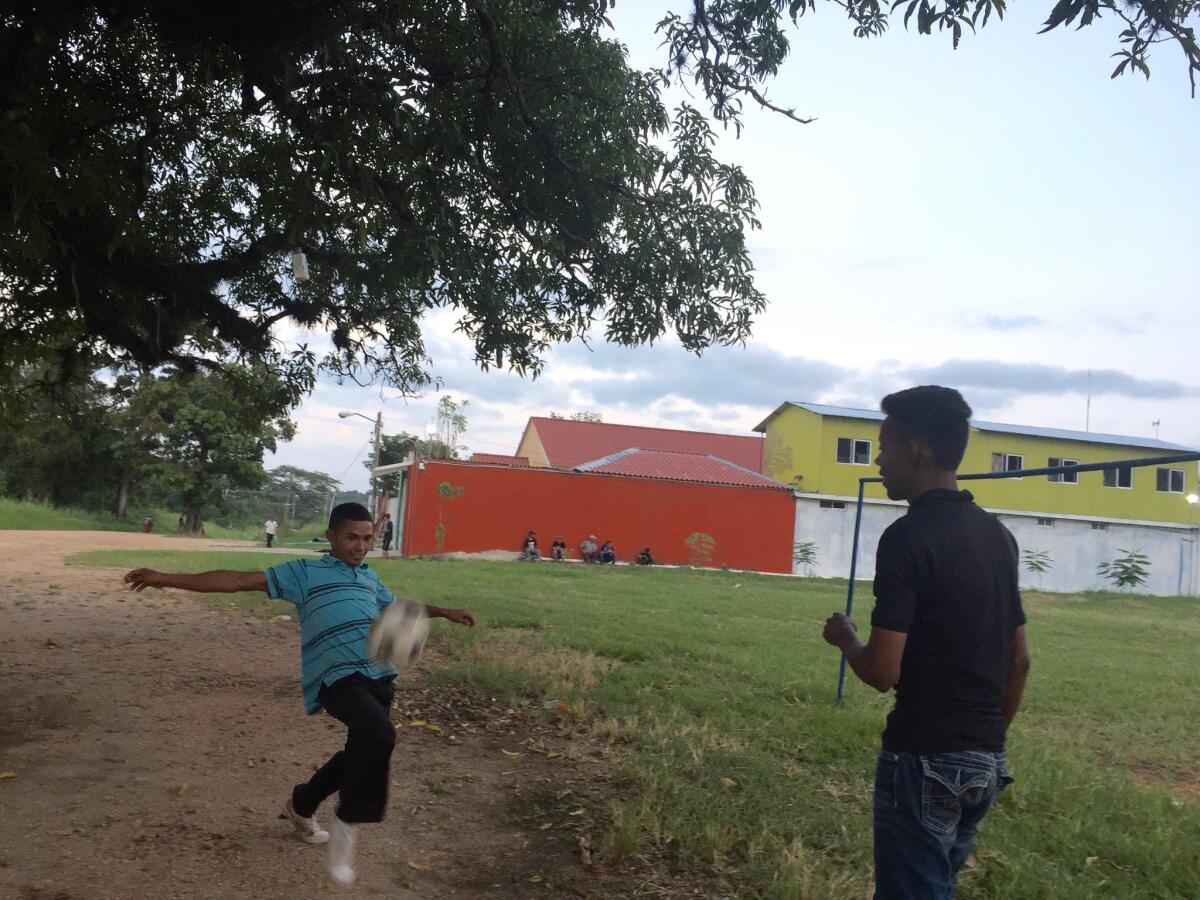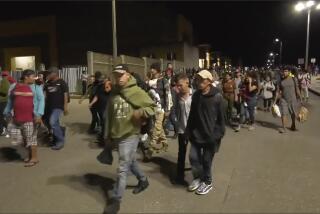More Central Americans are giving up on the U.S. and looking instead to a Mexican dream

Estimates of how many Central Americans are living in Mexico are hard to come by, in part because some have obtained forged Mexican identity documents.
Unable to find work and terrified by the street gangs that brazenly roamed the streets, Karen Zaldivar was one of tens of thousands of young people who fled Honduras in 2014.
Caught trying to slip across the U.S.-Mexico border, she was promptly deported.
Last year, Zaldivar set out again, but with a new destination: Mexico. She now lives in a small city just north of the Guatemalan border along with growing numbers of other Central Americans who have concluded that if they can’t reach the United States, the next best thing is Mexico.
“I decided to make a life here,” she said at a small open-air restaurant in Tenosique, where she works in the kitchen, frying fish. “It’s calmer, and safer.”
Estimates of how many Central Americans are living in Mexico are hard to come by, in part because some, like Zaldivar, have obtained forged Mexican identity documents. But statistics show more and more are staying legally by seeking political asylum or humanitarian visas.
Asylum applications in Mexico nearly tripled over three years, hitting 3,424 in 2015. Asylum requests this year are poised to be twice that, human rights advocates say, with most filed by Hondurans and Salvadorans.
I decided to make a life here. It’s calmer, and safer.
— Karen Zaldivar, Honduran immigrant in Mexico
The number of migrants seeking to stay in Mexico pales in comparison to the droves heading to the U.S. — more than 400,000 people were apprehended at the U.S. southern border in the fiscal year that ended in September, most of them from Central America.
But the burden on Mexico and other countries is likely to increase if President-elect Donald Trump makes good on his promises to beef up border security and deport up to 3 million people living in the U.S. illegally.
Jaime Rivas Castillo, a professor at Don Bosco University in El Salvador who has studied the Central American diaspora, said faltering economies, as well as fear, drive migrants from their homelands. “There aren’t jobs for everybody, and people fear for their life,” Rivas said. “So they go look for other places to live, if not in the U.S. then in Mexico, Panama, Costa Rica or Nicaragua.”
Yessica Alvarado, 20, said she fled El Salvador last month after she was attacked on her way to nursing school by gang members angry that her grandparents had refused to pay an extortion fee.
“It’s hard getting to Mexico, but not as hard as getting to the U.S.,” Alvarado said.
On a recent afternoon, she sat on a sunny patio at a crowded Catholic migrant shelter in Tenosique chatting with a new acquaintance, a 27-year-old woman who escaped Honduras after her gang-member boyfriend beat her and threatened to kill her children. The shelter, La 72, was named for the 2010 massacre of 72 migrants in northeastern Mexico by members of a drug cartel.
Even with its long-running drug war and a sliding peso, Mexico boasts a degree of safety and economic stability not seen in Honduras and El Salvador, which are among the poorest and most dangerous nations in the world. The roots of the violence there can be traced in part to the mass deportation of Los Angeles gang members to Central America in the 1990s. Experts say those countries aren’t prepared to reintegrate large numbers of new deportees.
Javier Eduardo Ferrera, 23, was deported to Honduras from North Carolina in September after police discovered cocaine in the car that he was driving.
Six days after he was released in the Honduran capital of Tegucigalpa, Ferrera left for Tenosique. He didn’t feel safe in Honduras, but he also didn’t want to risk ending up in prison if he was caught illegally crossing the U.S. border. Immigrants who have been previously deported and are discovered again in the U.S. can be charged with a federal crime punishable by up to two years in prison — a sentence Trump has threatened to increase to five years once he is in the White House.
“Let’s wait and see whether Trump accomplishes his goals,” said Ferrera, as he unfolded a crinkled document that gives him the right to temporarily stay in Mexico while his request for a humanitarian visa is processed. “If I can’t be there, I’d rather be here.”

A sleepy city built along a muddy river in the oil-rich state of Tabasco, Tenosique has long been a way station for migrants heading north. “La Bestia,” the infamous cargo train that has taken the limbs and lives of many migrants clinging to its roof on their way north, rolls through town.
In the past, immigrants would spend only a few days in Tenosique, resting and waiting for the train, said teacher Gaspar Geronimo Gonzalez. “Now, many stay,” he said. Some families live in cinder-block shacks near the train station, while others sleep near the river. The town’s schools enroll well over 100 children from Honduras, who can be distinguished by their accents and Central American slang.
The migrants are staying despite Mexico’s own crackdown on illegal immigration.
After tens of thousands of Central American children started streaming to the U.S. border in 2014, generating headlines, President Obama responded by requesting money from Congress to help improve conditions in Honduras and El Salvador. More quietly, his administration pressured Mexico to dramatically step up its own border enforcement.
Parts of the southern states of Chiapas, Oaxaca and Tabasco now resemble border communities of Arizona and South Texas, with an influx of federal agents, militarized highway checkpoints and raids on hotels frequented by migrants.
The result?
Mexican authorities deported close to 200,000 people last year, and between October 2014 and May 2015, they detained more Central American migrants than the U.S. Border Patrol. Human rights advocates expect 2016 to be the year with the highest number of detentions and deportations yet.
Advocates have raised concerns about the treatment of migrants by Mexican immigration authorities, citing cases of extortion and abuse. They have also called on the Mexican government to slow deportations and approve more asylum requests. Last year, only 1,207 out of 3,486 were granted.
They say gang violence makes the current exodus from Honduras and El Salvador far different than previous waves of economic migration, and insist the U.S. and Mexico should recognize immigrants from those countries as refugees.
“What we need right now is a humanitarian response to the situation in Central America that recognizes an essential truth: that seeking refuge or asylum is not illegal,” said Geoff Thale, director of programs at an advocacy group called the Washington Office on Latin America. “It is a fundamental human right.”
Some in Mexico have questioned whether the country has the capacity to help Central Americans when it already is struggling to integrate hundreds of thousands of Mexican nationals deported from the U.S. in recent years. Many of them arrive in the country of their birth with little Spanish and face bureaucratic barriers to attending school and finding work.
Teofila Montejo De La Cruz, a 72-year-old woman in Tenosique, worries her Los Angeles-based son will be deported under Trump, and wonders if he will be able to find a job in Mexico if he has to come back.
Montejo has become known as a guardian angel for the Central American immigrants in Tenosique, giving them work in her restaurant and letting them sleep on the floor of her snack shop. But even she doesn’t believe large numbers of Central Americans should be able to stay permanently in Mexico.
“At some point, they have to go back to their own land,” she said.

For now, most people who pass through her shop have eyes only for America. Like Wilmer Mauricio Lopez, 19, and his two friends.
Lopez worked as a bus driver in Honduras but grew tired of being threatened by gang members strapped with guns “like policemen” who would corner him and say: “You’re either with us or we’ll kill you.” He fled to Mexico.
On a recent day, word spread through the shelter where he and his friends were staying that a northbound train was headed towards Tenosique. He said he knew that even if he reached the U.S., immigration agents might catch and deport him. “But I want to go and see what happens,” he said. “Only God really knows.”
He and his friends grabbed their few possessions and set off toward the tracks.
Twitter: @katelinthicum
Click here for a Spanish version of this story
ALSO
Mexico instructs its embassy and consulates in the U.S. to increase measures to protect immigrants
‘Mexico is one big cemetery’: The search for the secret graves of ‘the disappeared’
More to Read
Start your day right
Sign up for Essential California for news, features and recommendations from the L.A. Times and beyond in your inbox six days a week.
You may occasionally receive promotional content from the Los Angeles Times.







